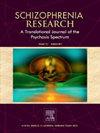Predictors of symptomatic and wellbeing remission in real-world samples of patients living with schizophrenia treated with aripiprazole once-monthly by means of constrained confidence partitioning
IF 3.5
2区 医学
Q1 PSYCHIATRY
引用次数: 0
Abstract
Introduction
An important goal in the treatment of patients living with schizophrenia is to achieve remission of schizophrenia symptoms and patient well-being. The possibility to predict which patients will achieve remission may inform treatment decisions. We derived different models for this on the basis of data from a German real-world study, part of which were tested for their predictive power by independent data obtained from a similar Canadian study.
Methods
Here, we used a sample of patients living with schizophrenia who participated in a 6-month non-interventional study of aripiprazole once-monthly. Data of patients with complete datasets (n = 194) were used to predict remission of symptoms (cross-sectional Andreasen criteria as measured by the Brief Psychiatric Rating Scale, BPRS) and well-being (as measured by the WHO-5 well-being index) at 6 months using logistic regression as well as the constrained confidence partitioning (c2p) method.
Results
Logistic regression yielded a model with the variables remission stats at baseline, Global Assessment of Functioning (GAF) score at baseline and age. Quality indicators suggested acceptable model quality, and we were able to validate the model using external data from the Canadian study. Models for remission of well-being and combined remission of symptoms and well-being were of poor quality. Modeling using c2p yielded defined groups of patients with differential likelihoods of achieving remission of symptoms, well-being, or both. In general, patients with lower scores in core symptoms, higher GAF scores, younger age, and higher WHO-5 scores showed increased likelihoods of achieving remission. The c2p model of symptomatic remission was also validated using external data from the Canadian study, and we demonstrated the possibility to generate and test hypotheses based on the model.
Conclusion
Despite only using a comparatively small sample, both logistic regression and c2p can produce reliable results with mathematically desirable properties. Patients with less severe core symptoms, better functioning, younger age, and better well-being may achieve symptomatic remission and remission of well-being more easily than other patients. The latter may need additional interventions in order to achieve remission.
使用阿立哌唑治疗每月一次的精神分裂症患者的现实世界样本中症状和健康缓解的预测因子
精神分裂症患者治疗的一个重要目标是实现精神分裂症症状的缓解和患者的健康。预测哪些患者将达到缓解的可能性可以为治疗决策提供信息。我们根据德国一项真实世界研究的数据推导出了不同的模型,其中部分模型的预测能力通过加拿大一项类似研究获得的独立数据进行了测试。方法在这里,我们使用了一组精神分裂症患者,他们参加了为期6个月的阿立哌唑非介入性研究,每月一次。使用完整数据集的患者数据(n = 194)预测6个月时症状缓解(由简短精神病学评定量表(BPRS)测量的截面Andreasen标准)和幸福感(由WHO-5幸福感指数测量),采用logistic回归和约束置信分割(c2p)方法。结果logistic回归得到的模型包含基线时的缓解统计、基线时的总体功能评估(GAF)评分和年龄。质量指标表明可接受的模型质量,我们能够使用来自加拿大研究的外部数据验证模型。幸福感缓解和症状与幸福感联合缓解的模型质量很差。使用c2p建模产生具有不同可能性的患者组,这些患者达到症状缓解、幸福感或两者兼而有之。一般来说,核心症状评分较低、GAF评分较高、年龄较小和WHO-5评分较高的患者实现缓解的可能性增加。症状缓解的c2p模型也通过来自加拿大研究的外部数据得到了验证,我们证明了基于该模型产生和检验假设的可能性。结论:尽管只使用相对较小的样本,逻辑回归和c2p都可以产生具有数学上理想性质的可靠结果。核心症状较轻、功能较好、年龄较小、幸福感较好的患者可能比其他患者更容易实现症状缓解和幸福感缓解。后者可能需要额外的干预以达到缓解。
本文章由计算机程序翻译,如有差异,请以英文原文为准。
求助全文
约1分钟内获得全文
求助全文
来源期刊

Schizophrenia Research
医学-精神病学
CiteScore
7.50
自引率
8.90%
发文量
429
审稿时长
10.2 weeks
期刊介绍:
As official journal of the Schizophrenia International Research Society (SIRS) Schizophrenia Research is THE journal of choice for international researchers and clinicians to share their work with the global schizophrenia research community. More than 6000 institutes have online or print (or both) access to this journal - the largest specialist journal in the field, with the largest readership!
Schizophrenia Research''s time to first decision is as fast as 6 weeks and its publishing speed is as fast as 4 weeks until online publication (corrected proof/Article in Press) after acceptance and 14 weeks from acceptance until publication in a printed issue.
The journal publishes novel papers that really contribute to understanding the biology and treatment of schizophrenic disorders; Schizophrenia Research brings together biological, clinical and psychological research in order to stimulate the synthesis of findings from all disciplines involved in improving patient outcomes in schizophrenia.
 求助内容:
求助内容: 应助结果提醒方式:
应助结果提醒方式:


